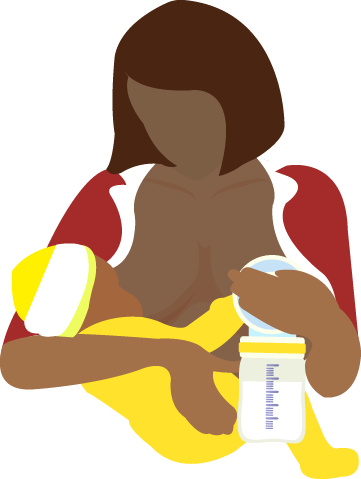Days 5 to 28
Your baby will get better at breastfeeding as the first month progresses. Expect to feed your baby about 8 to 12 times in 24 hours. Let your baby tell you when he or she is finished eating. When the baby self-detaches from the nipple, you can offer the other breast. Some babies feed better between breasts if you change their diapers and burp them. Usually a baby will breastfeed for a shorter period at the second breast. Sometimes he or she may not want to feed on the second breast at all. Simply offer the second breast first at the next feeding.
Your baby should continue to:
Soak 6 or more diapers a day with clear or pale yellow urine
Pass 3 or more loose, seedy, or curd-like yellow stools every day
Gain weight. Babies typically gain 2/3 ounce to 1 ounce each day, up to 3 months of age.
Talk to your baby’s healthcare provider if you think your baby is not eating enough.
General tips beyond the first few weeks
Every baby is different. Some will eat quickly and some will take longer to savor each drop. Others will take frequent breaks during each feeding. It is important to let your baby lead each feeding. This self-detachment will increase the amount of higher fat and higher calorie milk (hindmilk) that your baby will get. But once the breast is mostly empty, some babies will keep wanting to suck as a way of self-soothing. Over time you will be able to tell when your baby is switching to this self-soothing sucking. If your baby continues to suck in this way and it’s painful, gently detach your baby. If breastfeeding is well established, you can offer a pacifier instead. If you aren’t sure if your baby is full, try offering the other breast.
Your baby probably will go through several 2 to 4 day growth spurt periods. During this time, he or she will seem to want to eat almost around the clock. Babies often have a growth spurt between 2 to 3 weeks, 4 to 6 weeks, and again at about 3 months. It’s important to let a baby feed more often during these spurts. Within a few days, your baby will go back to a more typical pattern.
Let your baby set the pace for breastfeeding. Pay attention to his or her feeding cues. Here are some examples of feeding cues:
Turning the head toward the breast
Licking the lips
Smacking the lips
Being awake
Crying (this is a late sign of hunger)
The number of feedings each baby needs and the length of time each feeding lasts will vary from baby to baby. Also, every mother’s milk production and storage capacity is different. Trying to force a breastfed baby to wait longer between feedings, or to fit a certain feeding schedule, can result in poor weight gain.
Source: Johns Hopkins Medicine




